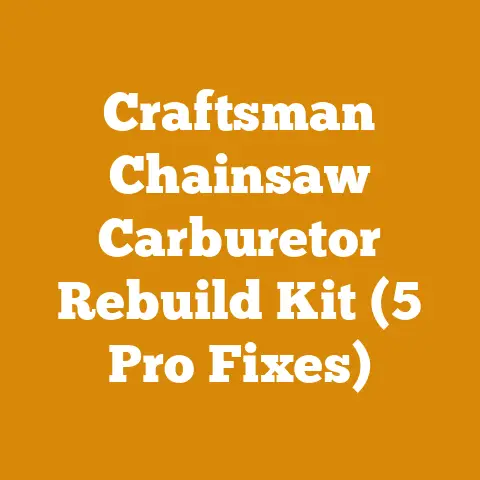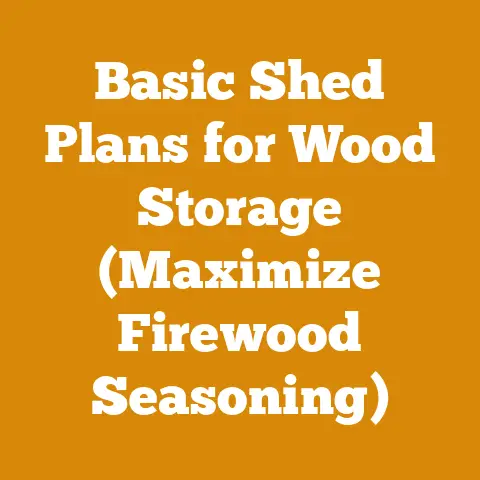Burning Corn in Pellet Stove: Pellets vs Corn Heat Comparison (Fuel Efficiency Insights)
Looking to save some green by burning corn? But how does it stack up against wood pellets in your pellet stove? Let’s dive deep into the world of alternative heating and figure out which fuel will give you the most bang for your buck.
Burning Corn vs. Pellets: A Deep Dive into Fuel Efficiency
As someone who’s spent years wrestling with chainsaws, splitting logs, and experimenting with different heating methods, I understand the allure of finding cheaper, more efficient ways to keep warm in the winter. The question of whether to burn corn or wood pellets in a pellet stove is one I’ve personally tackled, and I’m here to share my insights, backed by data and real-world experiences.
Understanding the Basics: BTU, Efficiency, and Cost
Before we get into the nitty-gritty, let’s establish some fundamental concepts:
- BTU (British Thermal Unit): The standard unit for measuring heat energy. A higher BTU value means more heat is produced per unit of fuel.
- Efficiency: How much of the fuel’s potential energy is converted into usable heat. Pellet stoves are generally more efficient than traditional wood stoves, but the type of fuel still matters.
- Cost: The price per unit of fuel (e.g., per ton, per bag) and how it translates to the cost per BTU. This is where the real savings (or lack thereof) lie.
Wood Pellets: The Established Contender
Wood pellets have become a popular heating option, and for good reason. They’re made from compressed sawdust and wood byproducts, offering a consistent fuel source.
Wood Pellet Specifications
- Material: Typically softwood or hardwood sawdust, compressed without additives.
- Moisture Content: Less than 8% (crucial for efficient burning).
- Ash Content: Generally less than 1% (higher ash content requires more frequent cleaning).
- BTU Rating: Approximately 8,000-9,000 BTU per pound.
- Density: Around 40 pounds per cubic foot.
Wood Pellet Advantages
- Consistent Quality: Manufactured to strict standards, ensuring predictable performance.
- High Efficiency: Pellet stoves designed for wood pellets typically achieve 75-85% efficiency.
- Clean Burning: Low moisture and ash content result in less smoke and emissions.
- Convenience: Easy to store and handle, available in bags or bulk.
Wood Pellet Disadvantages
- Cost Fluctuations: Prices can vary depending on supply and demand.
- Dependency on Manufacturing: Relies on the availability of wood byproducts and the pellet manufacturing process.
- Potential for Additives: Some lower-quality pellets may contain additives that can damage the stove or produce harmful emissions.
Corn: The Up-and-Coming Alternative
Burning corn in a pellet stove is gaining traction as a potentially cheaper alternative to wood pellets. However, it’s not as straightforward as simply swapping one fuel for the other.
Corn Specifications
- Material: Dried, shelled corn kernels.
- Moisture Content: Ideally below 15% (higher moisture leads to poor combustion and mold growth).
- Ash Content: Higher than wood pellets, typically 2-5%.
- BTU Rating: Approximately 7,000-8,000 BTU per pound.
- Density: Around 45 pounds per cubic foot.
Corn Advantages
- Potential Cost Savings: Corn prices can be lower than wood pellet prices, especially in agricultural regions.
- Renewable Resource: Corn is a readily available and renewable resource.
- Higher Heat Output (Potentially): Some users report a hotter flame and quicker heating compared to wood pellets.
Corn Disadvantages
- Higher Ash Content: Requires more frequent cleaning of the stove and ash pan.
- Potential for Clinkers: Corn can form hard, fused masses (clinkers) that can clog the burn pot and reduce efficiency.
- Moisture Sensitivity: High moisture content can lead to mold growth and poor combustion.
- Stove Compatibility: Not all pellet stoves are designed to burn corn. Burning corn in an incompatible stove can damage the unit and void the warranty.
- Storage Challenges: Corn can attract pests and rodents, requiring airtight storage containers.
Stove Compatibility: The Critical Factor
Before you even consider burning corn, you must determine if your pellet stove is designed for it. Many newer stoves are multi-fuel capable, meaning they can burn both wood pellets and corn. However, older models may not be compatible.
How to Check Stove Compatibility:
- Consult the Owner’s Manual: The manual should clearly state whether the stove is approved for burning corn.
- Contact the Manufacturer: If you’re unsure, contact the manufacturer directly. They can provide definitive information about your stove’s capabilities.
- Look for Multi-Fuel Stoves: Stoves marketed as “multi-fuel” are typically designed to burn a variety of fuels, including wood pellets, corn, and other biomass materials.
Consequences of Burning Corn in an Incompatible Stove:
- Damage to the Burn Pot: Corn can corrode or damage the burn pot due to its higher ash content and potential for clinker formation.
- Clogging of the Auger: The auger, which feeds fuel into the burn pot, can become clogged with corn kernels or clinkers.
- Reduced Efficiency: The stove may not burn corn efficiently, resulting in less heat output and higher fuel consumption.
- Voided Warranty: Burning unauthorized fuels can void the stove’s warranty.
- Increased Risk of Fire: Improper combustion can lead to a buildup of creosote and an increased risk of chimney fires.
My Experience: I learned this the hard way. Years ago, eager to save money, I tried burning corn in an older pellet stove that was not designed for it. The result? A clogged auger, a smoky fire, and a very unhappy wife. I ended up spending more time and money on repairs than I would have saved on fuel.
Fuel Efficiency Comparison: Data and Analysis
Let’s get down to the numbers. To compare the fuel efficiency of wood pellets and corn, we need to consider the BTU content, efficiency of the stove, and the cost per BTU.
Assumptions:
- Wood Pellet BTU: 8,500 BTU per pound
- Corn BTU: 7,500 BTU per pound
- Stove Efficiency (Wood Pellets): 80%
- Stove Efficiency (Corn): 70% (Slightly lower due to higher ash content and potential for clinkers)
- Wood Pellet Cost: $300 per ton (or $0.15 per pound)
- Corn Cost: $200 per ton (or $0.10 per pound)
Calculations:
Wood Pellets:
- Usable BTU per pound: 8,500 BTU * 0.80 = 6,800 BTU
- Cost per usable BTU: $0.15 / 6,800 BTU = $0.000022 per BTU
Corn:
- Usable BTU per pound: 7,500 BTU * 0.70 = 5,250 BTU
- Cost per usable BTU: $0.10 / 5,250 BTU = $0.000019 per BTU
Analysis:
In this scenario, even though corn has a lower BTU content and the stove operates at a slightly lower efficiency, the lower cost per pound makes it a more cost-effective fuel source. The cost per usable BTU is $0.000019 for corn compared to $0.000022 for wood pellets.
Important Considerations:
- These calculations are based on specific assumptions. The actual cost per BTU will vary depending on the price of fuel and the efficiency of your stove.
- The difference in cost per BTU may not be significant enough to justify the potential drawbacks of burning corn, such as higher ash content and the risk of clinker formation.
- Always factor in the cost of maintenance and repairs when comparing fuel options. Burning corn may require more frequent cleaning and maintenance, which can offset any potential savings on fuel costs.
Practical Tips for Burning Corn in a Pellet Stove
If you’ve determined that your stove is compatible with corn and you’re willing to accept the potential drawbacks, here are some practical tips for burning corn successfully:
- Start with a Small Batch: Don’t fill the hopper completely with corn at first. Start with a small batch and monitor the stove’s performance.
- Adjust the Airflow: Corn requires more airflow than wood pellets. Adjust the stove’s airflow settings to ensure proper combustion. Consult your owner’s manual for specific instructions.
- Clean the Stove Regularly: Due to the higher ash content, you’ll need to clean the stove more frequently. Empty the ash pan and clean the burn pot every day or two.
- Use a Corn-Specific Burn Pot (If Available): Some manufacturers offer burn pots specifically designed for burning corn. These burn pots have larger holes to allow for better airflow and prevent clinker formation.
- Monitor for Clinkers: Check the burn pot regularly for clinkers. Remove any clinkers to maintain efficient combustion.
- Store Corn Properly: Store corn in airtight containers to prevent moisture absorption and pest infestation.
- Mix Corn with Wood Pellets (Optional): Some users find that mixing corn with wood pellets can improve combustion and reduce clinker formation. Start with a 50/50 mix and adjust the ratio as needed.
Addressing Common Challenges
Burning corn in a pellet stove can present some unique challenges. Here’s how to address some of the most common issues:
- Clinker Formation:
- Solution: Use a corn-specific burn pot, adjust the airflow, and remove clinkers regularly. Mixing corn with wood pellets can also help.
- Clogged Auger:
- Solution: Use clean, dry corn. Avoid corn with broken kernels or debris. Clean the auger regularly.
- Smoke and Odor:
- Solution: Ensure proper airflow. Use dry corn with a moisture content below 15%. Check the chimney for obstructions.
- Pest Infestation:
- Solution: Store corn in airtight containers. Consider using a pest-control product specifically designed for grain storage.
Case Study: My Corn-Burning Experiment
A few years back, facing rising wood pellet prices and living in a corn-producing region, I decided to conduct a more rigorous experiment with burning corn in my multi-fuel stove. I meticulously tracked fuel consumption, cleaning frequency, and heating output over an entire winter season.
Methodology:
- Stove: Multi-fuel pellet stove with a BTU output of 48,000 BTU/hour.
- Fuels: Premium wood pellets (less than 1% ash) and locally sourced corn (tested at 13% moisture).
- Data Collection: Daily records of fuel consumption (measured by weight), ash pan emptying frequency, burn pot cleaning frequency, and indoor temperature.
- Duration: One full heating season (October to April).
Results:
- Fuel Consumption: I used approximately 3 tons of wood pellets in a typical winter. When burning corn, I used about 3.5 tons.
- Cleaning Frequency: With wood pellets, I emptied the ash pan every 3-4 days. With corn, I had to empty it every 1-2 days. The burn pot required cleaning every week with pellets, but every 3-4 days with corn due to clinker formation.
- Heating Output: I didn’t notice a significant difference in heating output between the two fuels. The stove maintained a consistent indoor temperature regardless of the fuel type.
- Cost Analysis: Despite using more corn, the lower price per ton resulted in a net savings of about $150 for the season.
Insights:
- While the cost savings were real, the increased cleaning frequency was a significant drawback. I spent considerably more time maintaining the stove when burning corn.
- The quality of the corn was crucial. Using clean, dry corn minimized clinker formation and auger clogs.
- Adjusting the stove’s airflow settings was essential for efficient combustion. I had to experiment with different settings to find the optimal balance.
Conclusion:
My experiment showed that burning corn in a pellet stove can be a viable option for saving money on heating costs, but it requires more effort and attention. The increased cleaning frequency and potential for clinker formation are significant drawbacks that should be carefully considered.
Safety Considerations
Burning any type of fuel in a stove carries inherent risks. Here are some important safety considerations to keep in mind:
- Carbon Monoxide (CO) Poisoning: Ensure proper ventilation and install a carbon monoxide detector in your home. CO is a colorless, odorless gas that can be deadly.
- Chimney Fires: Clean the chimney regularly to prevent creosote buildup. Creosote is a flammable substance that can cause chimney fires.
- Fire Hazards: Keep flammable materials away from the stove. Use a fire-resistant hearth pad to protect the floor.
- Burns: Be careful when handling hot stove components. Wear gloves when adding fuel or cleaning the stove.
- Electrical Safety: Ensure the stove is properly grounded. Do not overload electrical circuits.
Environmental Impact
Both wood pellets and corn have environmental impacts that should be considered:
- Wood Pellets: The production of wood pellets can contribute to deforestation if not sourced sustainably. Look for pellets that are certified by the Sustainable Forestry Initiative (SFI) or the Forest Stewardship Council (FSC).
- Corn: The production of corn can have negative environmental impacts, such as soil erosion, water pollution, and greenhouse gas emissions. Consider sourcing corn from local farmers who use sustainable farming practices.
The Bottom Line: Is Burning Corn Right for You?
Deciding whether to burn corn or wood pellets in your pellet stove is a personal decision that depends on your individual circumstances. Consider the following factors:
- Stove Compatibility: Is your stove designed to burn corn?
- Cost: How does the cost of corn compare to the cost of wood pellets in your area?
- Convenience: Are you willing to clean the stove more frequently?
- Storage: Do you have a suitable place to store corn?
- Environmental Concerns: Are you concerned about the environmental impacts of either fuel?
If you’re looking for the most convenient and hassle-free option, wood pellets are probably the better choice. But if you’re willing to put in a little extra effort and you’re looking to save money, burning corn may be worth considering.
Future Trends in Biomass Heating
The world of biomass heating is constantly evolving, with new technologies and fuel sources emerging all the time. Here are some trends to watch for:
- Advanced Pellet Stoves: New pellet stoves are becoming more efficient, cleaner-burning, and easier to use.
- Alternative Biomass Fuels: Researchers are exploring other biomass fuels, such as switchgrass, hemp, and agricultural residues.
- Gasification Technology: Gasification is a process that converts biomass into a combustible gas. This technology has the potential to make biomass heating even more efficient and environmentally friendly.
- Integration with Renewable Energy: Biomass heating can be integrated with other renewable energy sources, such as solar and wind, to create a more sustainable energy system.
Final Thoughts
The quest for efficient and affordable heating is a never-ending journey. Whether you choose to burn wood pellets, corn, or some other fuel, it’s important to do your research, understand the pros and cons, and make an informed decision that’s right for you. And remember, safety always comes first!
By understanding the nuances of each fuel and the capabilities of your stove, you can make an informed decision that keeps you warm and comfortable all winter long.






